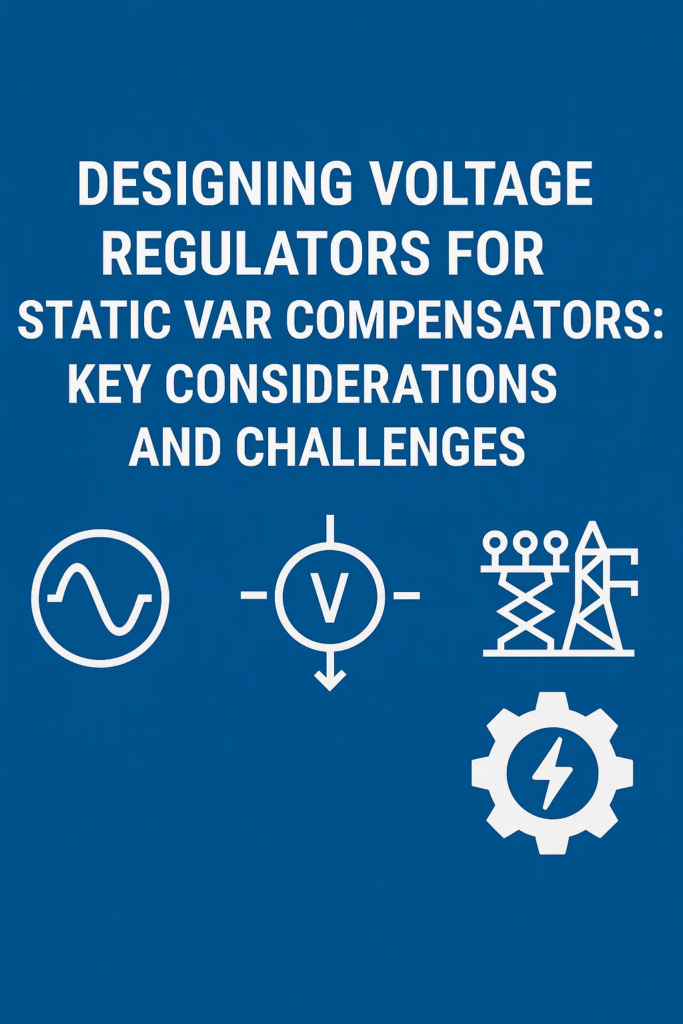Introduction
Maintaining the stability and consistency of electric power systems is one of the most vital tasks of grid operators—and voltage regulation lies at the heart of this challenge. In large industrial grids and utility-scale networks, Static Var Compensators (SVCs) play a vital role in reactive power recompense, voltage maintenance, and improving power quality. But for SVCs to perform professionally and dynamically, their voltage regulators must be robust, adaptive, and smart.
In this blog, we’ll break down:
- What voltage regulators in SVCs do
- Why they’re critical to modern power systems
- Key technical and design considerations
- The biggest challenges engineers face
- Emerging solutions and innovations
Let’s unravel the complexity—one voltage pulse at a time.
Understanding the Role of Voltage Regulators in SVCs
Static Var Compensators are part of Flexible AC Transmission Systems (FACTS). SVCs are primarily used to inject or absorb reactive power based on grid conditions, which helps control the voltage at a specific node in the power network.
A voltage regulator in an SVC system performs the following functions:
- Maintains the voltage set point at the SVC terminal
- Responds to grid fluctuations by dynamically regulating reactive power
- Controls thyristors in devices like Thyristor-Controlled Reactors (TCRs) or Thyristor-Switched Capacitors (TSCs)
- Ensures power system stability, especially during fault retrieval or peak load conditions
Without a precision-designed voltage regulator, an SVC could become inactive, cause voltage fluctuations, or even destabilize the network.
Key Design Considerations
Designing an effective voltage regulator involves a delicate balance of electrical, digital, and system-level requirements. Here are the most serious design parameters:
1. Control Strategy Selection
You’ll typically be choosing between:
- Proportional-Integral-Derivative (PID) controllers
- Model Predictive Control (MPC)
- Adaptive or fuzzy logic-based controls
Each method has trade-offs:
- PID is well-understood and simple
- MPC offers better dynamic response
- Fuzzy logic adapts better to nonlinear grid conditions
A hybrid approach is progressively common.
2. Response Time and Bandwidth
Voltage regulators must respond in milliseconds, particularly under fast-changing load situations. Engineers must optimize:
- Sampling rate
- Actuator delay
- System latency
High-bandwidth control loops allow rapid response—but also demand faster processors and better cleaning.
3. Voltage Set point Management
Regulators often operate with a dead band to prevent unnecessary actuation. But tight voltage control can battle with reactive power flow objectives. Advanced regulators adapt the set point in real time based on grid feedback and load trends.
4. Coordination with Other Grid Devices
Voltage regulators should coordinate with:
- OLTC (On-Load Tap Changers)
- Capacitor banks
- Dispersed generation
- Battery energy storage
The SVC must not “fight” other voltage control devices—which means inter-device communication protocols (like IEC 61850 or Modbus) need to be embedded in the regulator design.
5. System Modeling and Simulation
Regulators are tested using:
- Small signal stability analysis
- Root locus and Bode plots
- Time-domain EMT (Electromagnetic Transient) simulations
Imitation models must accurately represent grid dynamics, including nonlinearities, harmonics, and external faults.
Design Challenges Engineers Face
Building and mixing voltage regulators for SVCs isn’t just about code and circuits—it’s a multidimensional challenge. Let’s look at the most common pain points engineers contend with:
1. Nonlinear Grid Behavior
Grid voltage doesn’t always behave linearly. During faults, sudden load changes, or generator tripping, the system can become highly nonlinear. Standard linear regulators (like PID) may underperform or even destabilize the system.
Solution: Adaptive controllers or those based on real-time system modeling (MPC) can better handle nonlinear dynamics.
2. Harmonics and Noise Interference
SVCs themselves can vaccinate harmonics. The presence of harmonics affects sensor readings and control accurateness. Voltage regulators must therefore incorporate:
- Digital filtering (low-pass, notch filters)
- Robust signal conditioning
Hardware EMI defensive is often necessary in high-voltage switchyards.
3. Coordination in Multi-SVC Systems
In large networks, multiple SVCs may operate simultaneously. If not coordinated, they can create fluctuations or voltage hunting.
Solution: Ranked control architecture with master-slave configurations or peer-to-peer communication can resolve conflicts.
4. Cybersecurity and Grid Protocols
As voltage regulators become smarter and networked, they become potential vectors for cyber attacks. Hackers could spoof voltage data or hijack control algorithms.
Solution: Secure firmware, encrypted communication protocols, and imposition detection are progressively part of regulator design.
5. Environmental Conditions
SVC installations are often outdoors in harsh environments. Voltage regulators must be:
- Dustproof and waterproof (IP67+)
- Heat resistant (–40°C to +85°C)
- Immune to electrical surges (lightning protection)

Practical Implementation Tips
Here’s some field-proven advice from seasoned engineers:
- Always test the regulator under fault conditions using real or simulated fault situations
- Use redundant voltage sensing—multiple sensors increase reliability
- Implement fail-safe defaults—in case of data loss or communication failure, default the regulator to a traditional operating mode
- Ensure real-time visualization and diagnostics via HMI or SCADA systems
- Conduct thorough interoperability testing with nearby voltage control equipment
Case Example: Regulator Upgrade in a Steel Manufacturing Plant
A steel plant in India faced voltage unpredictability during arc furnace startup, causing brownouts in nearby facilities. An SVC was installed with a basic PID voltage regulator, but the system still oscillated under load.
Engineers refurbished the regulator:
- Implemented adaptive control logic
- Tuned real-time set point adjustment
- Added fast-reacting TSC modules
- Integrated with plant SCADA for predictive control
Result? The voltage deviation dropped by over 60%, and plant uptime improved dramatically.
What’s Next in Voltage Regulation for SVCs?
The future is bright—and faster.
Artificial Intelligence and Machine Learning are starting to penetrate voltage regulator design. These systems learn grid behavior patterns and expect voltage deviances before they occur. AI-enabled regulators will dynamically adjust and self-tune in real time.
Also on the horizon:
- Incorporation with renewable energy sources
- Grid-forming inverters working with SVCs
- Digital twins to pretend and optimize regulator designs
Final Thoughts
Voltage regulation for SVCs isn’t just about keeping the volts within bounds—it’s about flexibility, adaptability, and association between machine and grid. A well-designed voltage regulator gives the SVC not just precision, but intelligence. And as our grids become more dynamic, dispersed, and complex, this intelligence will be the difference between blackout and brilliance.
If you’re working on SVC systems or control engineering, don’t treat the voltage regulator as a mere subsystem—it’s the heart of your sensitive power solution.
